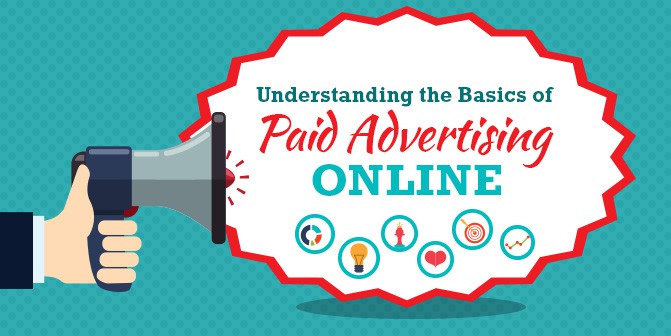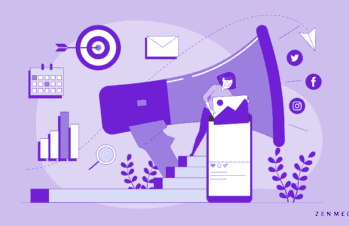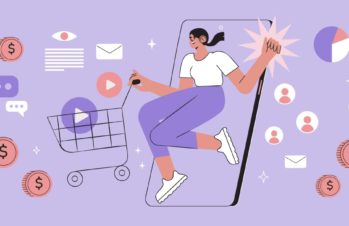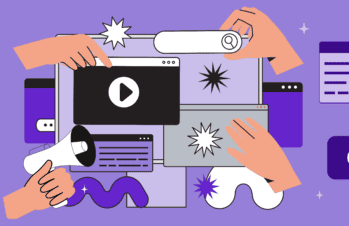We know, we know! Paid advertising brings up a lot of questions. Why pay for something when you can use so many other digital marketing techniques to drive traffic to your website and reach your audience? And does paying for ads mean that all those blog posts, regular social media posts, and search marketing strategies aren’t worthwhile? Not at all.
Here’s the deal: paid advertising on Facebook, Instagram, and other platforms isn’t meant to replace all those other marketing techniques. Instead, think of it as an extremely helpful supplement to your advertising strategy or another way to boost the number of people who see your ads (and make sure those people make up the relevant audience you’re trying to reach).
We’re not saying you should stop producing killer content for your blog or pull back from any social media or search strategies that you already have in place! We want to show you how paid advertising can enhance the techniques you’re already actively using to help you get the most out of your overall marketing strategy.
Social media trends, the emergence of AI, and other external factors are constantly impacting the customer journey, and marketers need to find ways to make sure their content and messages are reaching customers despite these changes.
Below, we’ll review ways to incorporate paid advertising to your marketing strategy.
Related read: Meeting Buyers Where They Are: From Sales-led to Marketing centric B2B Strategies
What is Paid Advertising?
Paid advertising is a form of marketing in which an organization pays a fee to a publisher or platform in exchange for displaying an advertisement to a specific audience. The goal of paid advertising is to reach a target audience and encourage them to take a specific action, such as visiting a website or making a purchase.
Paid advertising can take many forms, including search engine ads, social media ads, display ads, and native ads. These ads can be targeted to specific demographics or interests to increase their effectiveness.
Paid Advertising vs. Organic Advertising
The goal of paid advertising is to reach and attract potential customers and drive traffic to the advertiser’s website or product.
On the other hand, organic advertising refers to digital marketing strategies that are not paid for. These strategies rely on the content and relationships that a business has built with its audience to attract and retain customers. Some examples of organic advertising include social media posts, blog content, B2B email marketing, and search engine optimization (SEO).
Both paid and organic advertising can be effective ways to reach and engage with customers, but they differ in their approach and cost. Paid advertising is generally more immediate and can reach a wider audience more quickly, but it can also be more expensive. Alternatively, organic advertising takes more time to build but can be more sustainable in the long run and often has a lower cost.
Analyze the Benefits of Paid Advertising
As you work to increase the number of active, engaged followers across your social media pages, paid advertising can be an effective way to make sure you reach the right customers at the right time and in the right place.
Rather than relying on organic content to slowly and steadily grow your numbers, targeted advertising can supercharge your growth and engagement by providing you with a quick, easy way to get in front of new audiences who match your desired demographic.
Paid advertising has many different benefits for businesses, but the most widespread benefits are:
- Targeted advertising options to accommodate most marketing budgets
- Increased brand awareness
- The ability to reach your target audience and lookalike audiences
- The ability to incorporate CTA (call to action) buttons
Keep reading to find out how your business can get started designing a plan to reach your paid advertising goals.
Find Your Platform
Choosing a social media platform to advertise with can be difficult. Unsurprisingly, there is no one-size-fits-all model for deciding which platform is best for you. When your business is trying to decide whether to launch your paid advertising campaign on Facebook, X (formerly Twitter), Instagram, or any other social media network, it can be helpful to consider the following questions:
- Are your ads geared towards a B2B or B2C audience?
- Will this network help you reach your target audience?
- Does the ad format align with your marketing strategy?
Each of these questions really revolves around a common theme—reaching your audience! At the end of the day, you want to choose the platform that you think is most likely to get the right message in front of that audience. If you’re still unclear on exactly who your customer is, it’s best for you to take a step back and design your perfect customer profile. With this profile in place, you will be much better positioned to make the most of your paid advertising campaign goals.
A Breakdown of Paid Advertising Platforms
To further help narrow in on which social media site is best for your business, we’ve broken down five of the major platforms and their corresponding ad formats.
In the social media world, Facebook is one of the first platforms marketers think of—and with good reason! Facebook has over 3 billion active monthly users and 2.1 billion daily users. It’s also the top-rated social media platform for news consumption, with 30% of U.S. adults regularly getting news from the site. It makes sense that this is an important place to establish an organic presence, but how can you leverage the platform with paid advertising?
On Facebook, paid advertising options are organized based on the results that you’re trying to achieve and where you want your ads to be displayed.
Ad objectives include:
- Boosting your posts
- Promoting your page
- Sending people to your website
- Increasing conversions on your website
- Getting installs of your app
- Increasing engagement in your app
- Reaching people near your business
- Raising attendance at your event
- Getting people to claim your offer
- Increasing video views
- Collecting leads for your business
Ad locations include:
- Newsfeed
- Sidebar
- Mobile
- Audience network
Facebook’s ads allow marketers to choose specific qualities about the audience the ad will reach. You can target everything from gender, age, location, lookalike audiences, and more.
Once you’ve selected your audience and the post you want to run, the next step is determining your budget. Facebook charges either a daily budget (your ad is run continuously on a day-by-day basis until you hit your budget limit) or a lifetime budget (your ad will be run over a specified time frame that fits your budget).
Facebook ads are usually targeted to users based on their:
- Demographics
- Location
- Interests
- Other profile information
How much does it cost to advertise on Facebook?
There’s no hard and fast rule when it comes to Facebook ad budgets. The cost of Facebook ads depends on several variable factors, including:
- Audience targeting. It usually costs more to put your ads in front of a narrower audience as opposed to a broader one.
- Ad placement. Costs can change between ads shown on Facebook and Instagram.
- Campaign duration. The number of days and hours a campaign lasts impacts the final cost.
- Competitiveness of your industry. Some industries are more competitive than others for ad space. Ad costs usually increase the higher the product price is or how valuable the lead you’re trying to capture is.
- Time of year. Ad costs can fluctuate during different seasons, holidays, or other industry-specific events.
- Location. Average ad costs per country vary widely.
Businesses set an ad budget and bid for each click or thousand impressions the ad receives.
Like Instagram, Facebook ads appear throughout the app, including in users’ feeds, Stories, Messenger, Marketplace, and more. They look similar to normal posts but always include a “sponsored” label to show they’re an ad. Facebook ads include more features than regular posts, like CTA buttons, links, and product catalogs.
X (Formerly Twitter)
Though X trails behind its competitors when it comes to the average cost per thousand impressions (CPM), there are still advantages companies should consider when looking into paid advertising on the platform.
There are a variety of unique benefits to advertising your brand on X. First, the advertising reach on X is huge. In 2023 alone, the number of X users surpassed 250 million, with 550 million people visiting the site monthly.
Because of its rapid-fire communication and global reach, X offers a distinct platform for companies that want to tap into real-time conversations and trending topics.
Here are a few additional reasons to consider advertising on X:
Advanced Targeting Features. As a platform, X offers companies options that go beyond basic demographic and geographic targeting. Companies can now target users based on specific interests, behaviors, keyword usage in posts, and even the devices they use. This level of granularity allows for personalized ad experiences that are more likely to move your target audiences to take action.
Diverse Ad Formats. The variety of ad formats offered is an advantage. From promoted posts to in-feed video ads, X allows businesses to customize ads based on your objectives: brand awareness, website conversions, or user engagement. Each format provides unique ways for brands to capture attention and drive actions.
Transparent Analytics. Finally, X offers companies clear and detailed metrics, from impression data to engagement rates. These analytics help brands better gauge ad performance in real time and adjust strategies promptly, ensuring maximum impact and efficiency.
In contrast to Facebook and X, LinkedIn is primarily used for B2B marketing. Once you’ve mastered the basics of marketing on LinkedIn, it may be time to explore the paid advertising options available on the platform. Why? Because placing an ad on LinkedIn is an opportunity to grow brand mindshare within a community of more than 1 billion members globally. Marketers note the site has twice the conversion rate of other online audiences.
It is important to keep in mind that advertisements on LinkedIn tend to be more expensive than those on the platform’s B2C counterparts. LinkedIn outlines its minimum costs as $10 per campaign per day or $2 per CPC or CPM (cost per click or cost per thousand impressions).
LinkedIn offers a variety of ad format options:
- Carousel ads
- Conversation ads
- Event ads
- Follower ads
- Lead gen forms
- Message ads
- Single image ads
- Single job ads
- Spotlight ads
- Text ads
- Video ads
If you have the budget to advertise on LinkedIn, it provides an exceptional top-of-funnel tool for driving targeted audiences to your website and boosting your share of voice in your industry. By using your best-of-the-best content and targeting a focused audience, you can reach new people that your other marketing efforts may not be able to reach.
LinkedIn is still the world’s largest professional network. Consider paid LinkedIn advertising to drive traffic to your website, build brand awareness, and generate high-quality leads.
Dynamic advertising thrives on Instagram, where brands can benefit from a combination of visual and written content to reach audiences. Housed under Meta’s umbrella, Instagram offers another engaging way to attract and interact with customers.
With over 2 billion monthly active users, advertising on Instagram can be beneficial to your business. Despite having fewer users than Facebook, Instagram users spend more time on the app—33.1 minutes a day compared to Facebook’s 30.9 minutes.
Post a combination of text, images, and videos to increase your reach and understand user behavior. You can seamlessly repurpose your content across the platform, turning a post into an ad if it’s performing well or if it fits a current trend.
Determining which type of ad to use boils down to your advertising goals and preferences. For example, in-feed ads have a higher click-through rate than Stories ads. In-feed ads are just that—ads users see as they scroll through their feeds. Stories ads are unique to Instagram’s Stories platform, where user-generated content expires after 24 hours. Ads can live longer in Stories based on your budget and business goals. Either way, both types of ads are designed to mimic posts from non-paid users. And while in-feed ads may drive more clicks for brands than Stories ads, it’s important to reach customers via both methods.
Related read: 16 Ways to Promote Your B2B Brand On Instagram
Google Ads
The last paid advertising platform that we are going to explore is Google Ads. Though it’s not a social platform, it is one of the largest advertising networks in the world. Businesses can use Google Ads to reach new customers and, ultimately, help their organizations grow.
And when you talk to marketers about Google Ads, they typically jump right to pay-per-click (PPC).
PPC advertising is the core of Google Ads. It refers to the process where advertisers can bid for the opportunity to display their advertisements to users who enter specific keywords into a Google search. For example, department stores like Macy’s, JCPenney, and Lord & Taylor might bid for the opportunity to display an ad for their brand when someone enters the search term “department store” into Google.
With Google Ads, the keyword is king. To fully optimize this tool, you need to know the most relevant keywords for your business and what your target customers are searching for. This way, you can bid on the keywords that will give you the most conversions and business possible. Like other paid advertising tools, Google only charges you when someone clicks your link (cost-per-click bidding) and shows that your advertising is working. There is no minimum bid amount. Instead, you decide your maximum CPC bid amount to determine how much you’re willing to pay per click. You can do this manually or let Google handle automatic bidding based on your advertising budget. You may even be charged less than your max CPC bid amount.
Additional Examples of Paid Advertising
Search engine advertising: Pay to display advertisements in the sponsored results section of a search engine, such as Google. Advertisers bid on keywords that they think users will search for, and their advertisements are displayed when those keywords are entered into the search engine.
Display advertising: This involves paying to display advertisements on websites or other online platforms, such as banner ads or pop-up ads.
Social media advertising: Promote posts or advertisements on social media platforms, such as Facebook, Instagram, or LinkedIn.
Video advertising: This involves paying to display advertisements before, during, or after online videos, such as on YouTube or other streaming platforms. Just like display and social media advertising, video advertisers can target their ads to specific audiences based on demographics, interests, and other factors.
Print advertising: A more traditional route, print advertising still holds value in our modern world. Pay to place advertisements in print media, such as newspapers, magazines, or brochures.
Radio advertising: Did you know 91% of the population listens to AM/FM radio? This makes radio an excellent platform for paid ads played either during specific programs or at specific times of day.
Television advertising: Airing ads on television can reach regional and national audiences during specific programs or at specific times of day.
The Final Word
Now that you’ve read through the basics of paid advertising across several platforms, we hope you feel confident in your ability to delve into a new category of marketing. While it may be overwhelming to venture into this new realm, you can ensure success by educating yourself on your options and choosing the one that works best for you. If you need any help getting started or carrying out a paid advertising campaign, reach out to us today!




